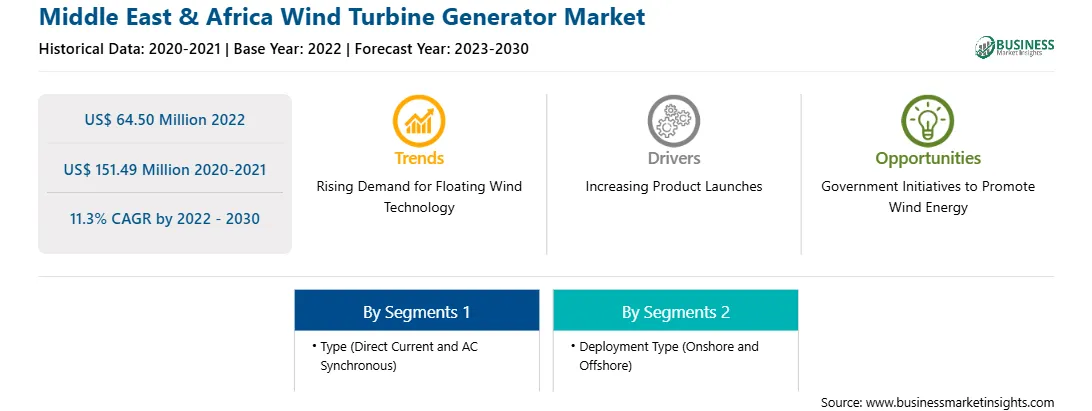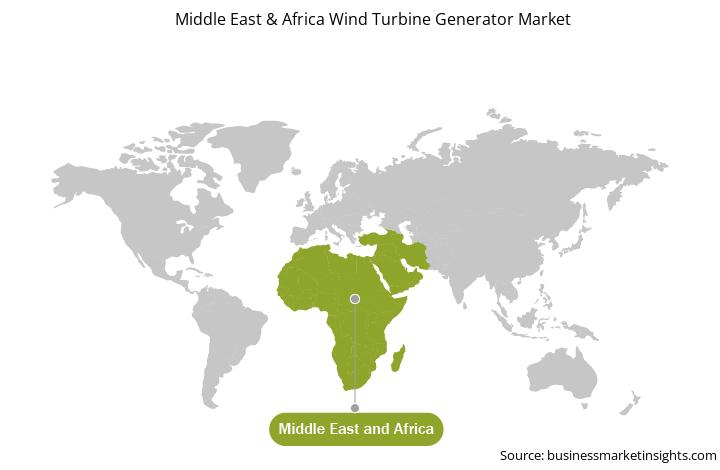The Middle East & Africa wind turbine generator market was valued at US$ 64.50 million in 2022 and is expected to reach US$ 151.49 million by 2030; it is estimated to grow at a CAGR of 11.3% from 2022 to 2030.
In deep water, the offshore wind turbine is mounted on a floating structure, which allows the turbine to generate electricity in the water depths. The floating wind technology is highly efficient in harsh conditions and, thus, capable of producing high power. Further, the demand for floating wind technology is growing in the market due to the increase in technological advancements, advantages associated with floating wind technology, and turnkey solutions provided by service providers. The growing awareness regarding clean energy in various countries is also propelling the demand for floating offshore wind power, thereby boosting the growth of the wind turbine generators and other components market.
Various investments are made in floating wind turbine projects by the governments of different countries. In addition, in June 2022, Equinor collaborated with Technip Energies to develop floating wind steel SEMI substructures that accelerate technology development for floating offshore wind. Saudi Arabia is constructing a 500 MW floating offshore wind farm in cooperation with the UAE-based renewables investor Plambeck and the Italian energy business Saipem. The project is expected to be operational by 2027. Further, in 2022, in order to establish a center for the construction of its floating wind platform at the Ferrofab Jebel Ali facility in the UAE, floating offshore wind platform developer Gazelle Wind Power (Gazelle) has signed a memorandum of understanding (MOU) with Ferrofab FZE (Ferrofab), an engineering and manufacturing firm based in the UAE.
The Middle East & Africa (MEA) wind turbine generator market is segmented into South Africa, Saudi Arabia, the UAE, and the Rest of MEA. South Africa, Egypt, Morocco, and Kenya are a few major countries dominating the wind energy demand. These countries are significantly contributing to wind energy production. The key factors responsible for the market growth are the increased initiatives for using clean energy sources to meet the rising power demand, supportive government policies, and reducing dependency on fossil fuels. For instance, in June 2022, a Saudi Arabian energy company signed an agreement with the Egyptian government. As per this agreement, the government will invest US$ 1.5 billion to develop a major wind project in Egypt. Upon completion, the facility will provide 1.1 GW of wind power, providing electricity to more than 1 million homes. Morocco, Egypt, and South Africa have successfully harnessed their wind potential, attracting private capital to set up wind parks.
According to the Global Wind Energy Council in April 2022, the MEA is expected to add 14 GW of new wind power capacity by 2026. These new wind power capacity additions in the MEA are primarily led by South Africa (5.4 GW), Egypt (2.2 GW), Morocco (1.8 GW), and Saudi Arabia (1.3 GW). In the MEA, onshore wind energy power generation technology has evolved over the last five years to increase the power generation capacity to cover more sites with lower wind speeds in the MEA region. In May 2022, Savannah Energy built a 500 MW capacity renewable energy power plant in the Republic of Chad, which includes a 100 MW wind farm that will serve N’Djamena city under a new agreement signed with the Chadian government. Thus, the integration of wind farms in renewable energy is augmenting the renewable energy capacity, reducing the emissions and dependency on fossil fuel-based power, which is further fueling the wind turbine generator market growth. Also, the growing investment in the construction of wind farms in the region is raising the demand for wind turbine generators. This is further pushing the manufacturers to produce more efficient components, further fueling the wind turbine generator market growth across the Middle East & Africa.
Strategic insights for the Middle East & Africa Wind Turbine Generator provides data-driven analysis of the industry landscape, including current trends, key players, and regional nuances. These insights offer actionable recommendations, enabling readers to differentiate themselves from competitors by identifying untapped segments or developing unique value propositions. Leveraging data analytics, these insights help industry players anticipate the market shifts, whether investors, manufacturers, or other stakeholders. A future-oriented perspective is essential, helping stakeholders anticipate market shifts and position themselves for long-term success in this dynamic region. Ultimately, effective strategic insights empower readers to make informed decisions that drive profitability and achieve their business objectives within the market. The geographic scope of the Middle East & Africa Wind Turbine Generator refers to the specific areas in which a business operates and competes. Understanding local distinctions, such as diverse consumer preferences (e.g., demand for specific plug types or battery backup durations), varying economic conditions, and regulatory environments, is crucial for tailoring strategies to specific markets. Businesses can expand their reach by identifying underserved areas or adapting their offerings to meet local demands. A clear market focus allows for more effective resource allocation, targeted marketing campaigns, and better positioning against local competitors, ultimately driving growth in those targeted areas.Middle East & Africa Wind Turbine Generator Strategic Insights

Middle East & Africa Wind Turbine Generator Report Scope
Report Attribute
Details
Market size in 2022
US$ 64.50 Million
Market Size by 2030
US$ 151.49 Million
Global CAGR (2022 - 2030)
11.3%
Historical Data
2020-2021
Forecast period
2023-2030
Segments Covered
By Type
By Deployment Type
Regions and Countries Covered
Middle East and Africa
Market leaders and key company profiles
Middle East & Africa Wind Turbine Generator Regional Insights

The Middle East & Africa wind turbine generator market is segmented based on type, deployment type, and country.
Based on type, the Middle East & Africa wind turbine generator market is bifurcated into direct current and AC synchronous. The AC synchronous segment held a larger Middle East & Africa wind turbine generator market share in 2022.
In terms of deployment type, the Middle East & Africa wind turbine generator market is bifurcated into onshore and offshore. The onshore segment held a larger Middle East & Africa wind turbine generator market share in 2022.
Based on country, the Middle East & Africa wind turbine generator market is segmented into Egypt, South Africa, Saudi Arabia, and the Rest of Middle East & Africa. South Africa dominated the Middle East & Africa wind turbine generator market in 2022.
Envision Energy USA Ltd, Mingyang Smart Energy Group Co, Nordex SE, Siemens Gamesa Renewable Energy SA, Xinjiang Goldwind Science & Technology Co Ltd, Vestas Wind Systems AS, General Electric Co, Suzlon Energy Ltd, and ENERCON GmbH are some of the leading companies operating in the Middle East & Africa wind turbine generator market.
1. Envision Energy USA Ltd
2. Mingyang Smart Energy Group Co
3. Nordex SE
4. Siemens Gamesa Renewable Energy SA
5. Xinjiang Goldwind Science & Technology Co Ltd
6. Vestas Wind Systems AS
7. General Electric Co
8. Suzlon Energy Ltd
9. ENERCON GmbH
The Middle East & Africa Wind Turbine Generator Market is valued at US$ 64.50 Million in 2022, it is projected to reach US$ 151.49 Million by 2030.
As per our report Middle East & Africa Wind Turbine Generator Market, the market size is valued at US$ 64.50 Million in 2022, projecting it to reach US$ 151.49 Million by 2030. This translates to a CAGR of approximately 11.3% during the forecast period.
The Middle East & Africa Wind Turbine Generator Market report typically cover these key segments-
The historic period, base year, and forecast period can vary slightly depending on the specific market research report. However, for the Middle East & Africa Wind Turbine Generator Market report:
The Middle East & Africa Wind Turbine Generator Market is populated by several key players, each contributing to its growth and innovation. Some of the major players include:
The Middle East & Africa Wind Turbine Generator Market report is valuable for diverse stakeholders, including:
Essentially, anyone involved in or considering involvement in the Middle East & Africa Wind Turbine Generator Market value chain can benefit from the information contained in a comprehensive market report.